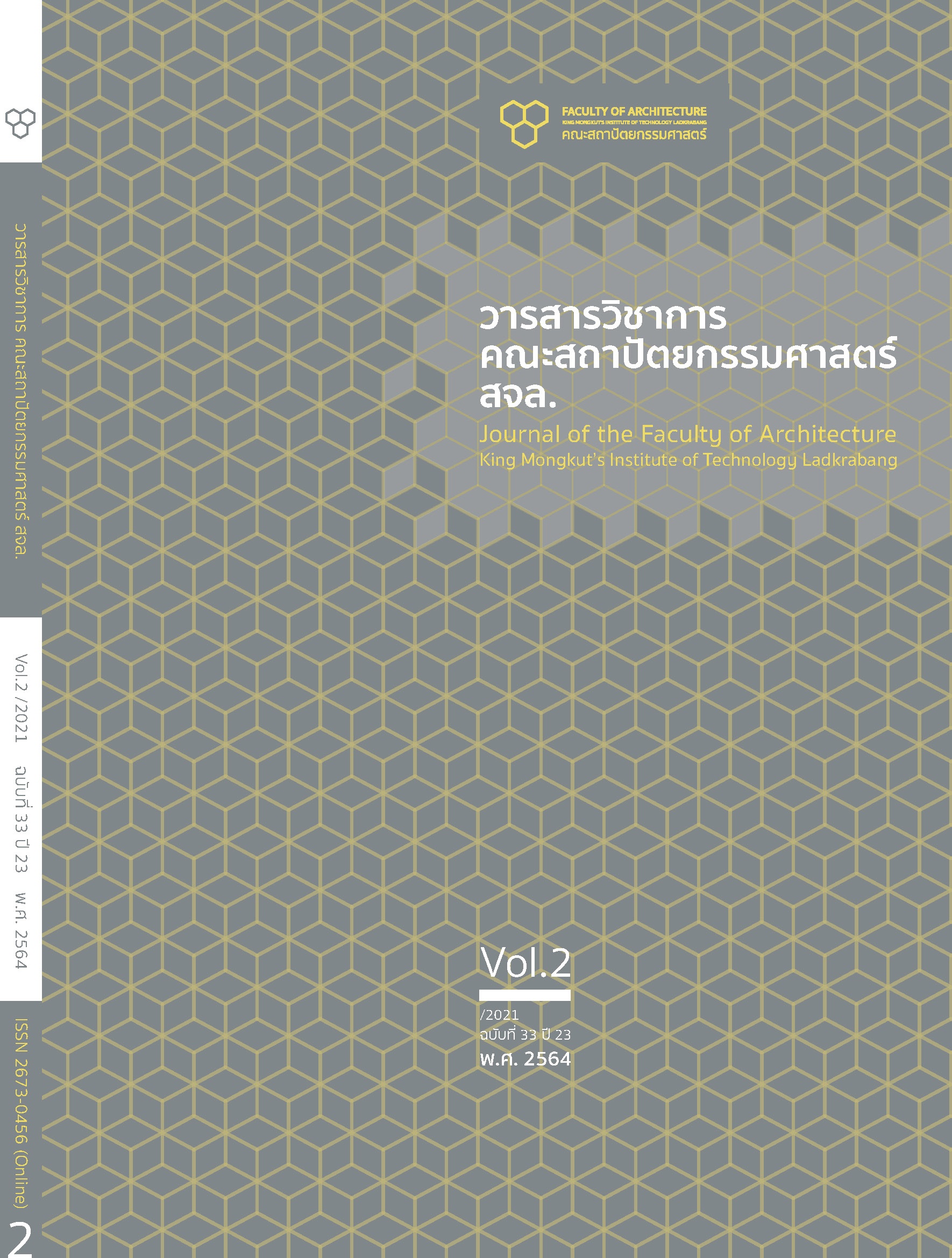Factors Influencing the Existence of Nang Loeng Community, Bangkok
Main Article Content
Abstract
Bangkok’s urbanization since B.E.2504 (A.D.1961) has been a result of the national development policies focusing on infrastructure and fostering economic development and investment. Nang Loeng Community, one of the traditional communities which has rich history, culture, and traditional ways of life, has been affected by the urbanization and resulted the diversity of physical, social, and economic changes. These changes raised awareness within the community towards adaptation to sustain its existence. This study aims to gather its development, and adaptation that lead to Nang Loeng Community’s roles in each period in order to analyze the levels of influence of factors that affect the existence of Nang Loeng Community to the present day (A.D.2020). Two sets of data were collected as follows: a set of secondary data was literature review of articles on community’s basic information and a set of primary data from surveying and interviewing two sample groups. One was a group of 5 communities and cultural leaders and the other was a group of 10 residences and outsiders. The results of the study show that the interrelationship among physical characteristics, social structure, economic activities, and external factor has influenced the existence of Nang Loeng Community’s a way of life and cultural identity. This finding could lead to policy recommendation to sustain the community’s existence amidst changes in the future
Article Details
This work is licensed under a Creative Commons Attribution-NonCommercial-ShareAlike 4.0 International License.
Copyright Transfer Statement
The copyright of this article is transferred to Journal of The Faculty of Architecture King Mongkut's Institute of Technology Ladkrabang with effect if and when the article is accepted for publication. The copyright transfer covers the exclusive right to reproduce and distribute the article, including reprints, translations, photographic reproductions, electronic form (offline, online) or any other reproductions of similar nature.
The author warrants that this contribution is original and that he/she has full power to make this grant. The author signs for and accepts responsibility for releasing this material on behalf of any and all co-authors.
References
กรมส่งเสริมวัฒนธรรม. (การสื่อสารส่วนบุคคล [สัมภาษณ์], 15 ตุลาคม 2563)
กฤตพร ห้าวเจริญ. (2560). เอกลักษณ์ทางกายภาพของตลาดชุมชนริมน้ำบริเวณริมแม่น้ำท่าจีน กรณีศึกษา จังหวัดสุพรรณบุรีและนครปฐม. วารสารวิชาการคณะสถาปัตยกรรมศาสตร์ สจล. 25(19), 37-50.
กัญญา ทิพโยสถ. (การสื่อสารส่วนบุคคล [สัมภาษณ์], 9 ตุลาคม 2563).
กาญจนา แก้วเทพ. (2533). สื่อส่องวัฒนธรรม. พิมพ์ครั้งที่ 1. กรุงเทพฯ: มูลนิธิภูมิปัญญา.
ชนินทร์ วะสีนนท์. (2554). คนรุ่นใหม่กับการพัฒนาท้องถิ่นอย่างยั่งยืน. วารสารวิจัยเพื่อพัฒนาเชิงพื้นที่. 4(4), 5-18.
ทองใบ เรืองนนท์. (การสื่อสารส่วนบุคคล [สัมภาษณ์], 9 ตุลาคม 2563).
ทิพย์วรรณ แขกสะอาด. (2561). การปรับปรุงอาคารเก่าตลาดนางเลิ้ง. (วิทยานิพนธ์สถาปัตยกรรมศาสตรบัณฑิต สาขาวิชาสถาปัตยกรรม, มหาวิทยาลัยศรีปทุม).
เทียมสูรย์ สิริศักดิ์. (2543). การศึกษาเพื่อการอนุรักษ์ย่านนางเลิ้ง. (วิทยานิพนธ์สถาปัตยกรรมศาสตรบัณฑิต สาขาการวางแผนภาคและเมือง, จุฬาลงกรณ์มหาวิทยาลัย).
ธนิก เลิศชาญฤทธ์. (2550). การจัดการทรัพยากรวัฒนธรรม. พิมพ์ครั้งที่ 1. กรุงเทพฯ: ศูนย์มานุษยวิทยาสิรินธร (องค์การมหาชน).
เมธินีย์ ชอุ่มผล และเกสรบัว อุบลสรรค์. (2559). เสวนาสาธารณะของคนย่านเก่าเมืองกรุงเทพฯ ครั้งที่ ๒ “ตลาดนางเลิ้ง ตลาดใหม่ (ซิงตั๊กลัก) ย่านชานพระนคร”. เข้าถึงได้จาก: https://lek-prapai.org/home/view.php?id=5088.
ยงธนิศร์ พิมลเสถียร. (2556). ย่านเมืองเก่าและชุมชนดั้งเดิมกับการอนุรักษ์. วารสารเมืองโบราณ. 39(2), 94-107.
เยี่ยมยุทธ สุทธิฉายา. (2561). เดินดูนางเลิ้งเมื่อวัฒนธรรมถูกใช้รองรับการพัฒนา สู่คำถามสิทธิในเมืองที่เท่าเทียม. เข้าถึงได้จาก: https://prachatai.com/journal/2019/01/80466.
วลัยลักษณ์ ทรงศิริ. (2559). ที่มาของชื่อ “นางเลิ้ง”. เข้าถึงได้จาก: https://lek-prapai.org/home/view.php?id=5071.
สำนักการผังเมืองกรุงเทพมหานคร และศูนย์ออกแบบและพัฒนาเมือง. (2562). Bangkok 250. เข้าถึงได้จาก:http://bangkok250.org/strategy/.
สำนักงานจัดการสิ่งแวดล้อมธรรมชาติและศิลปกรรม. (2559). คู่มือการอนุรักษ์สิ่งแวดล้อมศิลปกรรมประเภทย่านชุมชนเก่า. เข้าถึงได้จาก: http://www.onep.go.th/nced/wp-content/uploads/2016/09/คู่มือการอนุรักษ์สิ่งแวดล้อมศิลปกรรมประเภทย่านชุมชนเก่า.pdf.
สุภาภรณ์ จิดามณีโรจน์, ปิยะวดี อภิชาตบุตร และศรีศักร วัลลิโภดม. (2554). ย่านเก่าในกรุงเทพมหานคร. พิมพ์ครั้งที่ 1. กรุงเทพฯ: มหาวิทยาลัยศิลปากร
สุวรรณ แววพลอยงาม. การสื่อสารส่วนบุคคล [สัมภาษณ์], 1 ตุลาคม 2563).
Chapin, S.F. (1972). Urban Land Use Planning. 3rd ed. Urbana: University of llinois Press.
Leslie, R.M. (2005). The oxford handbook of health, communication, behavior change and treatment adherence. New York: Oxford university Press.
Rapoport, A. (1990). A Systems of Activities and Systems of Settings. Deomestic Architecture and the Use of Space. Cambridge: Cambridge University Press.
Thrift, N.J. (2003). Cultural Bodies: Ethnography and Theory. Oxford: Blackwell.


